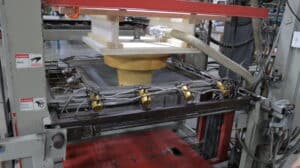Plastic Thermoforming
Plastic thermoforming is the process of converting a flat plastic sheet into a molded part. Thermoformers generally fall into two basic categories; thin gauge and thick gauge. Reliable Formed Plastics is a thick gauge thermoforming company. Thick/ heavy gauge, also referred to as sheet forming, is usually used for larger parts where a thicker material is required. It is the process used for small and large production runs or for prototyping parts. Most products can be formed using different processes. A brief conversation with our customer service department can help determine the best method for your application. The thermoforming process is a fairly simple sounding process which takes years of experience to master. There are a multitude of different types of plastic and often various blends of these types. Each type has its own distinct molding characteristics and each of these varying with thickness, size and depth of the part being formed. While all follow the basic rules of forming, each product and every material is usually processed differently. Dealing with all the variations becomes more of an art than an exact science. Simply stated, if it can be formed out of a sheet of plastic, we can do it. We can take a project from a drawing on a napkin to a finished product in a matter of days!
Concurrent Engineering and Development Process
Our concurrent engineering and development process usually begins with either a formal job quote submission or a customer supplying us with photos, sketches, or images of their idea for a product. In the latter scenario, with some back and forth discussion and brainstorming over the idea and its solutions, we determine whether or not Reliable Formed Plastics will be able to help a customer out with our in-house manufacturing capabilities. If we are unable to help a customer out, we will assist them in sourcing it elsewhere. Though more times than not, with our concurrent engineering background and innovative concepts, we have the means to help you come up with a custom solution.
CAD: From sketch to 3D computer model
 Reliable Formed Plastics LLC utilizes the latest version of SolidWorks 3D CAD modeling software. [SolidWorks is compatible with a number of other 3D CAD programs, including: Rhino, Pro-E, AutoDesk Inventor, AutoCAD, and SolidEdge]. After hand sketches have been created for initial visual communication, our concurrent engineering team further defines our client’s product by producing a 3-dimensional computer-aided concurrent engineering model. We can then pass on images and dimensional drawings for client approval. Taking it even one step further, our software allows us to send the client an actual 3D computer model that they can view, rotate, and zoom-in and out with a free program called eDrawings, which can be downloaded at – http://www.solidworks.com/sw/products/free-cad-software-downloads.htm. Even if you are not manufacturing any product and just need concurrent engineering work, we can help you out. Call us today.
Reliable Formed Plastics LLC utilizes the latest version of SolidWorks 3D CAD modeling software. [SolidWorks is compatible with a number of other 3D CAD programs, including: Rhino, Pro-E, AutoDesk Inventor, AutoCAD, and SolidEdge]. After hand sketches have been created for initial visual communication, our concurrent engineering team further defines our client’s product by producing a 3-dimensional computer-aided concurrent engineering model. We can then pass on images and dimensional drawings for client approval. Taking it even one step further, our software allows us to send the client an actual 3D computer model that they can view, rotate, and zoom-in and out with a free program called eDrawings, which can be downloaded at – http://www.solidworks.com/sw/products/free-cad-software-downloads.htm. Even if you are not manufacturing any product and just need concurrent engineering work, we can help you out. Call us today.
CAM: From computer model to physical model
Reliable Formed Plastics’ concurrent engineering department also uses MasterCAM, which is a computer-aided machining software. [MasterCAM is compatible with a number of programs like AutoCAD and Adobe; and accepts DXF and DWG file extensions among many others]. MasterCAM is the tool that links our solid modeling program with our CNC machines. After a solid model has been created, we import the model into MasterCAM and run the necessary software to mill the solid model shape out of stock material using our CNC machines. This creates the physical mold necessary for the next step in our process – Plastic Vacuum Forming.
Prototype Mold Fabrication
The first use of our 5-Axis CNC machines in our product development process is milling prototype molds. We typically use MDF (medium-density fiberboard) in our prototype mold fabrication. Though MDF is only good for a relatively short run in vacuum thermoforming, as it can deteriorate over longer runs, it is a more economical alternative to the more expensive epoxy board. Therefore, utilizing MDF in the mold prototype phase allows us to make adjustments in the mold and lower cost to our client, before we move into the more costly production run tooling.
Custom Vacuum Forming Overview
 There are a number of techniques available for forming plastics. Among them are injection molding, blow molding, rotational molding, and thermoforming. Thermoforming is often the process of choice, especially for prototyping and large parts, due to the low cost of molds and tooling. With thermoforming, a sheet of plastic is heated to a pliable forming temperature, stretched over the surface of a mold, and a vacuum is used to evacuate the air between the plastic and the mold. This creates a plastic shell that shares the same surface as the mold shape. The formed sheet is cooled down to a solid state, and then trimmed to create a usable plastic product. Reliable Formed Plastics is capable of forming up to a 6’x12′ sheet with a 2′-3′ draw.
There are a number of techniques available for forming plastics. Among them are injection molding, blow molding, rotational molding, and thermoforming. Thermoforming is often the process of choice, especially for prototyping and large parts, due to the low cost of molds and tooling. With thermoforming, a sheet of plastic is heated to a pliable forming temperature, stretched over the surface of a mold, and a vacuum is used to evacuate the air between the plastic and the mold. This creates a plastic shell that shares the same surface as the mold shape. The formed sheet is cooled down to a solid state, and then trimmed to create a usable plastic product. Reliable Formed Plastics is capable of forming up to a 6’x12′ sheet with a 2′-3′ draw.
Production Run Tooling
Once prototypes have been approved and final concurrent engineering adjustments have been made, we often create more molds in preparation for larger runs of parts. More molds means more parts per pull (or cycle through the thermoformer), which brings the per piece price down. We will often fabricate the production run molds out of a more durable epoxy board that has a much longer life cycle than MDF. This holds especially true for more complex mold geometries.
5-Axis CNC Part Routing
In addition to utilizing our 5-Axis CNC routers for milling prototype and production run molds, we use them for detailed trimming and cutting of the formed plastic parts. After a sheet of plastic has been vacuum formed, the parts are often rough trimmed with a hand router. Sometimes this rough trim is all that the parts need; but more times than not, we place them back on the CNC machine to trim a variety of patterns with precision and accuracy to tolerances of +/- 0.010″. In this case, we place the rough-routed plastic parts onto a custom made vacuum box, called a “trim fixture”, which is mounted onto the CNC machine. Next, using the ability to hold a variety of bits and blades in its dual-spindle head and its 5-Axis capabilities, our CNC machines afford the facility of trimming all around the plastic part in virtually any desired means.
Assembly and Packaging
Once parts have been formed and then trimmed, certain projects might have more than one part which needs to be assembled together with a mechanical fastener or a chemical welding agent. We have a designated area with appropriate tools necessary where our employees can achieve this crucial final step. We create custom “assembly fixtures” to aid in this process. Furthermore, we have the equipment and space necessary to safely package your final products to ensure a reliable delivery. Email us or call us to see if we can help produce your product or idea today.

